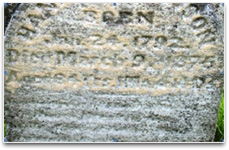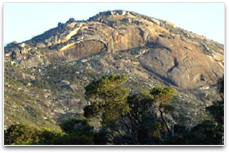This focus idea is explored through:
Contrasting student and scientific views
Student everyday experiences
 Very few students have any experiences relevant to rocks being formed. Even so there is a range of student ideas about rock formation. They often believe that the rocks we see in a particular place have always been there. Others may believe that the rocks were formed at some time in the past, but were formed in that place. Most students have seen footage of erupting volcanoes – and may see this as a rock forming process.
Very few students have any experiences relevant to rocks being formed. Even so there is a range of student ideas about rock formation. They often believe that the rocks we see in a particular place have always been there. Others may believe that the rocks were formed at some time in the past, but were formed in that place. Most students have seen footage of erupting volcanoes – and may see this as a rock forming process.
Students commonly classify rocks by their appearance, so, for example, quartz and feldspar may be seen as very similar rocks because they both appear white.
Students often acknowledge small scale erosion of rocks, such as smoothing of rocks due to weathering. However, most do not believe in large scale erosion such as a river creating a mountain valley or the Grand Canyon. When asked how a large mountain valley formed, students will often suggest Earth movements such as folding or faulting, rather than erosion. This is understandable and relates to the difficulties students have with the vastness of geological time.
The focus idea
Geological time explores student conceptions of geological time scales.
Generally students do not see that rock erodes to form soil, or that soil is really eroded rock. Many students believe that soil has always been present where it is; some students believe that soil is ‘pushed up from below’ and a related view is that all or most soils are primarily composed of organic matter.
Students often use the word rock to refer to a particular fragment (‘I picked up this rock’) rather than a type of material. Rock may also be restricted to material found in natural sites; rock found in building sites is regarded as ‘stone’, which is perceived as something different.
The focus idea
Properties of natural and processed materials explores student perceptions of modified materials.
Research:
Blake (2005),
Dove (1998),
Happs (1982),
Ford (2003),
Hawley (2002),
Kusnick (2002)
Scientific view
All exposed rocks have been made from older rocks by processes involving either sedimentation or significant heat and pressure. Many may have been recycled numbers of times.
The most common geological classification of rocks is based on the way the rocks are formed - sedimentary, metamorphic and igneous.
Sedimentary rocks are formed under water from the products of erosion (sediments) of older rocks. These products vary in grain size; two common products are clay and sand and these are the major components of most soils. Sand (silica) particles are easily seen with the naked eye while clay particles are quite small and require a strong microscope to be seen. Sedimentary rocks such as conglomerates also include much larger products of erosion - pebbles and larger pieces of older rock. It is the clay particles that act as a ‘glue’ (matrix) to bind the larger grains together in most sedimentary rocks. The type of sedimentary rock that forms is significantly influenced by the ways that water, wind or ice have moved and sorted the fine grained clay materials and the larger materials - sand and larger rock fragments. The rocks form because of pressure from the addition of more sediment on top; heat is not a significant factor.
Igneous rocks form from the cooling of molten material. Colliding tectonic plates slowly push some plates deep beneath the surface (a process called
subduction), where they melt. Sometimes this molten rock reaches the surface again via a volcanic eruption. Then it cools quickly and the rock that is formed is called volcanic e.g. basalt. Sometimes the molten rock cools underground and therefore much more slowly; the rock that is formed is called plutonic e.g. granite. Volcanic rocks are characterised by much smaller grains or crystals than plutonic rocks.
Both sedimentary and igneous rocks often have easily visible grains of different materials and geologists use these when identifying a rock. The grains in sedimentary rocks such as sandstone are often rounded, reflecting their long exposure to erosion; they need some sort of matrix to bind them together. The grains in igneous rocks such as granite are more angular and often clearly interlock, this reflects the fact that they have crystallised out together as the rock cooled from a molten state.
Metamorphic rocks are formed when one type of rock, often a sedimentary rock, is subjected to high temperature and pressure. The rock does not melt, but the temperature and pressure change the chemical structure and properties of the rock. Typically the new rock is harder and stronger than the older rock: for example, under heat and pressure limestone turns into marble and mudstone turns into slate. Because of the effects of the heat and pressure, grains are more difficult to identify in metamorphic rocks.
It is important to note that not all rocks go through the same series of changes as they are recycled, for example not all rock is eroded before it forms a new rock. The
subduction and subsequent melting of moving tectonic plates is probably the major rock recycling process. This means that the phrase ‘the rock cycle’ is misleading and best avoided.
While soils such as peat bogs are largely made of organic matter, most soils come from erosion of rocks with the major components being a mix of clay and sand particles. There is some organic matter in topsoils, but this is steadily broken down and rarely remains as a long-term component. This breakdown results in small levels of
trace elements which are often vital for plant growth.
In many areas of science, the same group of things can be classified usefully in several different ways. For example, it is sometimes useful to classify dingoes and ladybirds separately (as mammals and insects), and sometimes useful to classify them both as carnivores and thus different from sheep and locusts. Which of these two ways of classification is appropriate will depend on how the classification is used. When considering rocks on which a structure is to be built, civil engineers, for example, focus on whether or not the local rocks can support a new bridge or very large building; hence they classify the rocks by their hardness and strength.
Sedimentary rocks vary much more widely than igneous and metamorphic rocks in both strength and hardness.
Critical teaching ideas
- All exposed rock surfaces are continually eroding by chemical and mechanical action.
- Most rocks in our environment are recycled over very long periods of time.
- Rocks are recycled in different ways and factors such as erosion, heating and chemical reaction create rocks with different properties.
- Rocks can be classified in different ways; the classification used by geologists is based on how they were formed – this is only one way to classify rocks and other people use different classifications.
Using the analogy of other forms of recycling that students are familiar with is a fruitful approach. These other forms of recycling are not equivalent (to each other or to rock recycling), and it is important to explore how they are and are not similar to what can happen to rocks during erosion and subsequent rock formation. One point of difference is that rock recycling is always occurring – rocks do not ‘enter a rock cycle’ that produces a new rock in the way that (say) glass is recycled.
 Explore the relationships between ideas about rock formation and erosion in the
Concept Development Maps – Changes in the Earth’s Surface, Plate Tectonics.
Explore the relationships between ideas about rock formation and erosion in the
Concept Development Maps – Changes in the Earth’s Surface, Plate Tectonics.
Teaching activities
Open discussion via a shared experience
Give students an assortment of rocks, ask them to group the rocks and then write reasons for their groupings. This will bring out what students look for when they examine a rock – often colour and texture. The teacher can lead this reporting in ways that encourage students to focus on the visible grains in the rock.
Present images of situations where rock erosion has occurred. These situations should be both more or less obvious examples of rock erosion, such as:
-
 a very old tombstone
a very old tombstone - the Port Campbell coastline (where rocks are eroding relatively quickly)
-
 granite mountains at Wilson’s Promontory (where it is less clear that the rocks are eroding).
granite mountains at Wilson’s Promontory (where it is less clear that the rocks are eroding).
Open up discussion as to whether or not rock erosion is occurring and, if so, what is causing the erosion, where the eroded material is ending up, and where the sand on the beaches came from.
In situations where there is a demonstrably soft rock and a clear active agent for erosion – such as the cliff scenery in a number of places in Victoria, students are likely to be comfortable with the ideas of these rocks being eroded.
Bring out students’ existing ideas
Soil is a very common product of rock erosion. However, many students may not believe this. In this context, ask students where they think soil has come from and, as appropriate during the discussion, what they think would happen (over millions of years) if we removed all the soil from an area. Guide the discussion to explore whether new soil would reform and if so from what.
The same activity can be undertaken using beach sand as the example.
Challenge some existing ideas
To explore whether or not soil might come from eroded rocks, use stereo microscopes to look at some different soils and what is formed by crushing a small amount of some different rocks (use a hammer and a strong bag and then a mortar and pestle). Possibilities for soil are potting mix, soil from a garden bed, a high clay soil and sand; for rocks you could use granite and sandstone. The students are likely to agree that soil did contain tiny bits of rocks (the sand/silica grains are very noticeable).
Help students work out some of the ‘scientific’ explanation for themselves
Shake a large jar containing water and soil with different size components. Let the contents settle overnight. The intention of the activity is to help students to identify how water can assist in sorting and layering sediments often easily identified as coloured layers in silt and mud stone. The shaking simulates the action of a stream or river that is actively transporting and sorting material. The settling is analogous to what happens as the river slows or enters the sea and the sediment it is carrying is deposited.
Clarifying and consolidating ideas for communication to others
Use other forms of recycling (aluminium, paper and glass recycling) as analogies for rock recycling, but then invest time in looking at the ways in which the analogy does and does not map onto different kinds of rock recycling. This last stage is very helpful in building meaning.
Some relevant background information: plastic and paper are mixtures of a number of compounds that are not separated on recycling; this means that the range of possible recycled products is limited – recycled paper typically ends up as cardboard/egg cartons, not new best quality paper and recycled plastic may end up in rubbish bins, but not new fishing line (which needs pure nylon). Recycled glass is closer to the purer forms of new glass, but coloured pigments cannot be removed, nor can specialist types of glass such as lead crystal be made from recycled glass. Aluminium, on the other hand is recycled as the pure element that it is and so can be remade into any new aluminium product. Most rocks are
mixtures and what they are recycled into depends on both what they contain and how they are being recycled.
Clarifying and consolidating ideas for communication to others
Small groups of students can each take a different rock and prepare a poster or presentation to others about the recycling processes that led to their rock being formed. They might also look at some properties of their rock, how this may affect how it may be used and what sorts of groups in society would need to be interested in this e.g. mountain climbers, builders (rock as building material), engineers (rock as providing support for foundations) or stone age hunter gatherers.